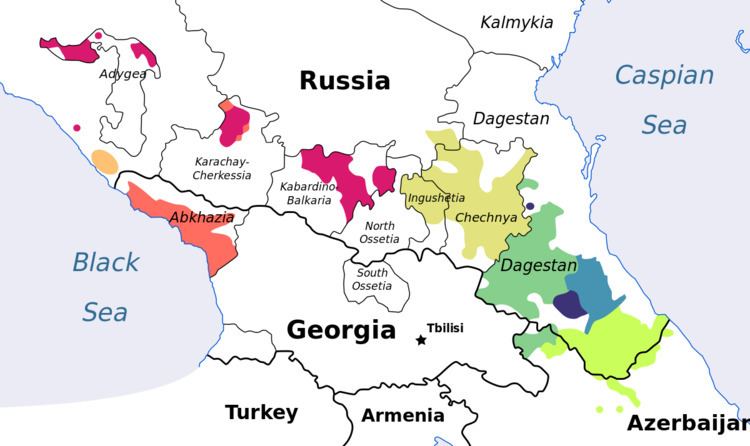Glottolog None | ISO 639-5 ccn | |
 | ||
Linguistic classification Proposed language family Subdivisions Northwest CaucasianNortheast (or Alarodian) | ||
The North Caucasian languages, sometimes called simply Caucasic, are a pair of well established language families spoken in the Caucasus, chiefly in the north: the Northwest Caucasian family, also called Pontic, Abkhaz–Adyghe, Circassian, or West Caucasian; and the Northeast Caucasian family, also called Nakh–Dagestanian or East Caucasian.
Contents
- Internal classification
- Comparison of the two phyla
- Main similarities
- Main differences
- Some comparisons
- Criticism
- References
Some linguists, notably Sergei Starostin and Sergei Nikolayev, believe that the two groups sprang from a common ancestor about five thousand years ago. However, this proposal is difficult to evaluate, and remains controversial.
There are some 34 to 38 distinct North Caucasian languages.
Internal classification
Among the linguists who support the North Caucasian hypothesis, the main split between Northeast Caucasian and Northwest Caucasian is considered uncontroversial. Problems arise when it gets to the internal structure of Northeast Caucasian itself. So far no general agreement has been reached in this respect. The following classification is based on Nikolayev & Starostin (1994):
Abkhazo-AdygheanHatticNakh–DaghestanianComparison of the two phyla
The main perceived similarities between the two phyla lie in their phonological systems. However, their grammars are quite different.
Main similarities
Both phyla are characterised by high levels of phonetic complexity, including the widespread usage of secondary articulation. Ubykh (Northwest) has 84 consonants, and Archi (Northeast) is thought to have 76.
A list of possible cognates has been proposed. However, most of them may be loanwords or simply coincidences, since most of the morphemes in both phyla are quite short (often just a single consonant).
Main differences
The Northeast Caucasian languages are characterised by great morphological complexity in the noun. For example, in Tsez, a series of locative cases intersect with a series of suffixes designating motion with regard to the location, producing an array of 126 locative suffixes (often – depending on the analysis – described as noun cases).
By contrast, the Northwest Caucasian noun systems are relatively poor in morphology, usually distinguishing just two or three cases. However, they make up with a very complex verbal structure: the subject, the direct object, the indirect object, benefactive objects and most local functions are expressed in the verb.
Some comparisons
Abbreviations: PN = Proto-Nakh, PDL = Proto-Dargi-Lak, PLK = Proto-Lezgic-Khinalugh, PAAT = Proto-Avar–Andic–Tsezic, PNEC = Proto-Northeast Caucasian, PNWC = Proto-Northwest Caucasian, PNC = Proto-North Caucasian; i = inclusive, e = exclusive
Abbreviations: PNEC (S) = Schulze, PNEC (N) = Nichols, PNWC (Ch) = Chirikba, PNWC (Co) = Colarusso, PNC (S) = Starostin & Nikolayev
Criticism
Not all scholars accept the unity of the North Caucasian languages, and some who do believe that the two are, or may be, related do not accept the methodology used by Nikolayev and Starostin.
